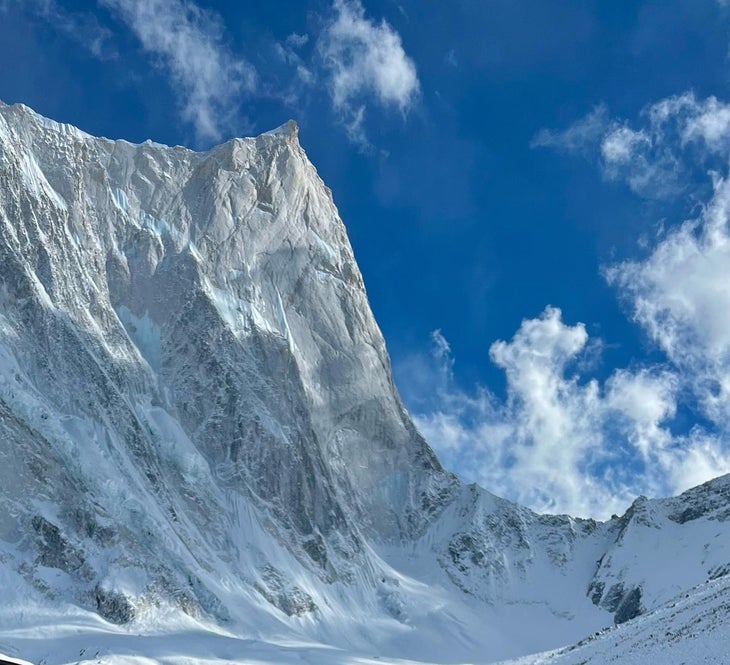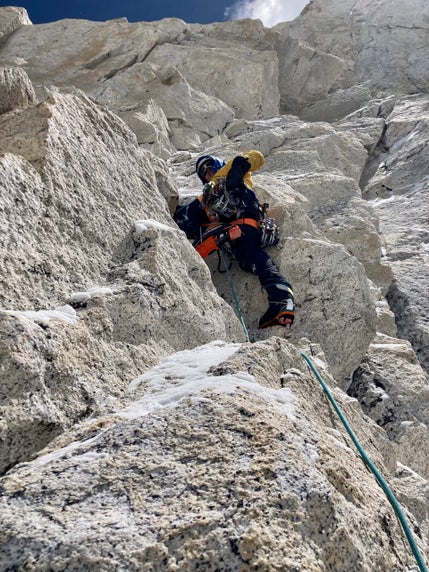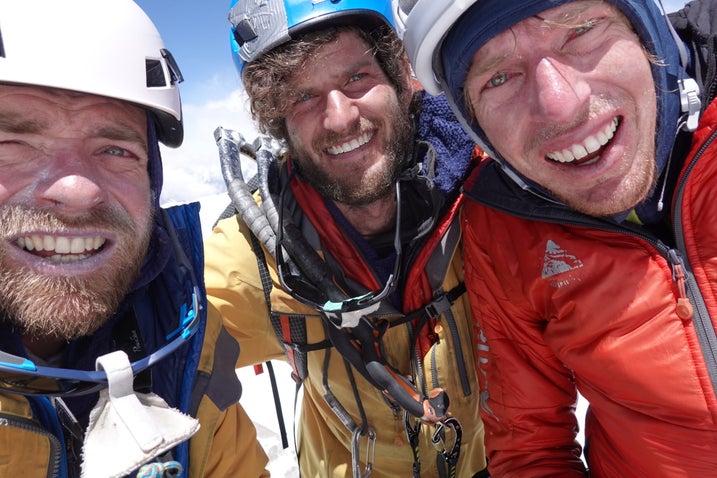Heading out the door? Read this article on the new Outside+ app available now on iOS devices for members! Download the app.
In the history of high altitude climbing, there are few ascents that have become legendary—in the truest sense of the word. A cutting-edge ascent, done in good style, is not nearly enough to become legend. Instead, the climb must be attempted, again and again, each failed ascent contributing to the lore surrounding the route.
Such is the case for Changabang’s (6,864 meters) immense West Wall, which has 1,600 meters of steep granite relief and was originally done in 1976 by the British alpinists Joe Tasker and Pete Boardman. Unlike the large-scale siege expeditions of the era, Tasker and Boardman’s lightweight team made the six-mile approach to advanced base camp as a team of two and began a 21-day odyssey up the wall, finding difficulties up to 5.10 and 90-degree ice. Factor in the thin-air, the brutally cold weather, and the long descent back to basecamp, the duo’s 40-day journey must have felt like ascending into another planet.
On May 2 this year, 46 years after the first ascent, Kim Ladiges and Matthew Scholes from Australia and Daniel Joll from New Zealand made the second ascent of the West Wall. While they undoubtedly followed in the footsteps of the legendary alpinists before them, their ascent opened roughly 20 pitches of entirely unclimbed terrain—a significant variation to the original route.

The team
“Two plus two equals four, five, six, or maybe even seven.” Daniel Joll told Climbing, to explain his belief that a “highly functioning team is greater than the individual sum of its members.” Joll said the team’s strength lay in its long history of climbing in the mountains together; among an untold number of attempts and failures, as pairs or as a trio, the team has ticked Cholatse’s North Face, Cerro Torre, the Grandes Jorasses North Face, and Taulliraju. These ascents have fostered a strong bond, Joll said, and allowed the group “to fail well, [which] builds real trust in your partners.”
Two years ago the trio decided that Changabang was their next great objective and resolved, with “complete commitment,” to be in fighting shape and develop a clear understanding of the route’s major difficulties.

Planning and training
The team reviewed the previous 20-odd attempts on the West Wall and realized that most teams failed due to logistical errors. Joll doubted that the West Wall’s technical difficulties would have stopped would-be suitors; it was the weather, the extreme cold, poor acclimatization, and lack of morale (or an excess of fatigue) from the extensive load carrying to the base of the route.
With this analysis in place, the trio developed a “rock-solid plan” for both the expedition and the fitness-focussed lead up; each member followed a three month program of cardio training supplemented with regular doses of outdoor climbing . Then, six weeks before their expedition, the team spent five weeks climbing in Chamonix together, dialing in their systems.
Shrinking Serac Opens Up Stout New Route on Mt. Hunter, Alaska
The climb
The team arrived at base camp on April 11 and began ferrying nearly 400 pounds of gear through steep moraines to their advanced base camp, six miles away, below the West Wall. Due to the tedious terrain, in their planning stages, the team had prepared to carry these loads for multiple weeks—but after just eight days of carrying their ABC was stocked and the team felt ready to blast off. They climbed and hauled from 5,150 meters up to 5,800 meters before fixing their ropes and returning to basecamp for two days of rest.
They set off again on April 25 with the intention of acclimating on their ascent, as Changabang’s neighboring peaks do not offer easy opportunities to acclimate. The team averaged 200–300 meters of ascent per day and, while slower than one would expect, Joll said this tactic worked well and thwarted the typical altitude-induced headaches.

The team carried two portaledges and one tent, a triple rack of cams, a full aid-climbing ensemble, ropes, an extensive piton rack, several sets of wires, 15 cans of gas, and ten days of food. The team was, no doubt, prepared for the terrain but the burden of hauling was evident on the many pitches of broken, blocky terrain. Thankfully, Joll said, Ladiges and Scholes are experienced wall climbers and overcame each obstacle smoothly.
Despite the massive wall before them, the heavy loads they hauled, and the constant possibility of frostbite, Joll said the team focused only on the task at hand: “During the load carries we never thought of what came next. Every carry was hard. We just focused on that day and said [that], as long as we get the gear to where we planned, tomorrow is a new day. … None of us ever thought we would summit. We never even imagined it could be possible until the final 100 meters. Every day we simply did our pitches and moved our gear, never thinking of how far we had to go, just the objective for the day.” This was another key factor to dealing with a route of this magnitude: “The sheer amount of effort required on a route like the West [Wall] can wear you down if you start thinking about all that is still to come.”
The team proceeded efficiently, never rushing but always in motion, with one person leading, another hauling, and the third cleaning the pitch and helping free the often-stuck haul bags. They had never a moment to relax, being busy from the morning “until the time the portaledge door got zipped up and we fell asleep.”

Looking back, Joll is adamant that it was the 22° F cold, not the technical difficulties, that were the crux of the West Wall. Indeed, 5.10 and steps of vertical ice may be within the realm of many experienced climbers, but tack on frozen, unfeeling hands and a shivering core? Joll recalled, “Climbing M5 and 80-degree ice at 6500 meters … I can tell you it’s bloody hard even when you’re just following and resting every few moves on your Micro traction.”
“Despite the fact that, after 46 years, we completed the first repeat of the famous Boardman-Tasker route, the ascent was a rather smooth affair,” Joll said. “Yes, we got caught in daily storms, one of which was very intense. … We had other minor dramas like on the final bivy where our tent started to slide off the small platform we had created on the edge of a 1000-meter drop. Needless to say we didn’t really sleep that night. Overall, though, this was a smooth ascent where teamwork and commitment paid off and we were eventually rewarded with a fine summit morning and a moment of warmth and sunshine just as we arrived at the final pitches of the climb.”

Federico Bernardi runs the Italian climbing-news website montagnamagica.com and gives his thanks to Daniel Joll’s daily trip diary for helping inform this article.
Ukranians Make Historic First Ascent on Annapurna III, Besting 40-Year Highpoint